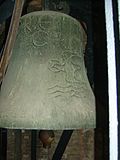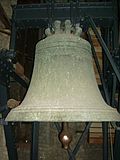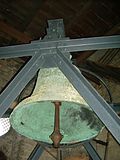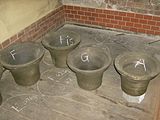Luther Church (Apolda)
| Luther Church | |
|---|---|
| Construction time: | 1890-1894 |
| Inauguration: | June 7, 1894 |
| Architectural style : | Neo-Gothic / Historicism |
| Space: | about 1000 |
| Location: | 51 ° 1 '30 " N , 11 ° 30' 58" E |
| Location: |
Apolda Thuringia , Germany |
| Purpose: | evangelical church |
The Luther Church in Apolda is a Protestant house of worship whose architectural style is neo-Gothic . It is located in the city center on Melanchthonplatz and is the largest of the four Apolda churches . The Luther Church was designed by the architect Johannes Otzen and built from 1890 to 1894. Visible from the outside, it is based on the brick Gothic style, which is unusual for Thuringia . The historicist interior design, which in contrast to most other comparable churches has been preserved unchanged, includes sculptures by Hermann Kokolsky and Wilhelm Haverkamp , the paintings by Otto Berg and the colored glass windows from Maximilian Auerbach's workshop. Also part of the original equipment of the church is the organ made by Wilhelm Sauer with 48 stops on three manuals and a pedal.
Building history
Plans for the new church
The first documented mention of Apolda falls in the year 1119. Apolda is mentioned as a settlement with two churches, the Martinskirche and the St. John's Chapel. The latter was demolished in 1524 when the castle was rebuilt. In the same year Apolda accepted Luther's teaching . The Martinskirche was gradually adapted to the needs of a large congregation of preachers. Since there were not enough seats in view of the increasing population, a new building was planned since 1720. This company came to a standstill again in 1738.
It was not until 103 years later that a citizens' initiative was formed to build a new church. A building fund was established, which was administered by the church building association. On the occasion of the 300th anniversary of the Reformer's death in 1846, the association was named Luther Association. However, almost five decades passed before the population's wish for a large new church to be built was fulfilled.
Laying of the foundation stone and topping-out ceremony
The construction of the Luther Church was estimated at 307,000 marks and was largely financed by donations from the citizens of Apolda. On June 29, 1890, the foundation stone was laid for the church on Antonienplatz, today's Melanchthonplatz. As early as 1890, the area, part of which was once used as a cemetery, was acquired by the city by the Protestant parish. The solemn laying of the foundation stone was preceded by a service in the Martinskirche. The address for the service, which was also attended by Privy Councilor Kuhn and General Superintendent Hesse, was given by Superintendent Küchler. The time capsule of the foundation stone contains records and documents about the laying of the foundation stone, the history of the Luther Association, the conditions in the city of Apolda, the donations for the church as well as other forms and documents. According to the plans of the Berlin architect Johannes Otzen, one of the most important church builders of the 19th century, work began on July 23, 1891. The construction management was carried out by the architect Adolf Cornehls .
The topping-out ceremony was celebrated on October 6, 1892 , and the consecration service was held on June 7, 1894 by the secret church councilor Förtsch from Mellingen . Grand Duke Carl Alexander and Grand Duchess Sophie as well as Hereditary Duke Carl August and his wife Pauline took part in the consecration . Church councilor Förtsch preached on the subject About your gate, O sanctuary, we write the big word: "There is no salvation in any other than in Christ." Therefore, be consecrated to a place of salvation: Salvation in Christ is your supplication, your life, your promise .
architecture
The Luther Church is located on the northern side of Melanchthonplatz. The approximately 72 m high main tower rises on the left corner of the entrance side. Behind it extends the narrower aisle, which is asymmetrically assigned to the main nave. The asymmetry of the floor plan proved to be liturgically advantageous. The benches of the main nave are aligned in a straight line with the short, five-sided choir . At its center stands the altar , on the left side of the baptismal font , on the right Chorgewände the pulpit . From the gallery opposite the pulpit side, which occupies the full width of the aisle , there is a favorable view of the pulpit, chancel and organ. It is worth mentioning that the altar faces south-west and thus does not follow the traditional orientation to the east.
The horizontal structure realized with the side gallery takes up the spacious organ gallery on the entrance side and a kind of walkway on the pulpit side of the ship. In return, the architect uses inwardly drawn buttresses and round pillars rising above the galleries to create clearly vertical lines. Arcade arches and rib vaults close off the spacious nave at the top. The vault , along with the four-part main windows, divided above by five-sided rosettes, is the special architectural ornament of the interior. Subtle decorative painting and the mysterious glow of the windows completely glazed with carpet patterns join the warm tone of the exposed bricks of the architectural elements. They were carried out by the firms "Victor von der Forst" from Münster and "Auerbach & Co." from Berlin based on the architect's designs. Medallions with Christian symbols are embedded in the slender pointed arched windows of the choir .
The image program extends to the choir arch, choir wall and altar. Particularly eye-catching are the statues of the apostles Paul and Peter on the choir arch, which were created by the Berlin sculptor Hermann Kokolsky. A relief depicting the Lord's Supper is inserted as the lower altarpiece , which, according to Jesus' words, repeatedly communicates his blessings. Above this one sees Christ on the cross with the promise: I have come that they may have life and be fully satisfied. The four great prophets were placed in the canopies next to the crucifix . The figures of the four evangelists, which are Haverkamp's works, surround the walls of the choir.
Furnishing
Bells
The largest church in the bell town of Apolda still has a bell from 1722, which was cast by Johann Christoph Rose ( nominal : e 1 , a major third bell). At that time, efforts should probably already be made to build a new church, which was only carried out with the Luther Church at the end of the 19th century. At the same time, the Apolda tradition of bell foundries was established.

The big bell (nominal: c sharp 1 ) had to be replaced twice. The current bell was cast by Franz Schilling junior in 1950 after the previous bell was melted down for war purposes. The small bell (nominal: g sharp 1 ) was made in 1870 by Carl Friedrich Ulrich for the Luther Church, which was already planned.
| photo | Foundry / casting location |
Font type | year | Ø (mm) | Weight (kg) | Nominal | Bell decorations and inscriptions |
Bell story |
|---|---|---|---|---|---|---|---|---|
| Franz Schilling Sons (Apolda) No. 6242 | bronze | 1950 | 1459 | 2100 or 1985 |
c sharp1 or des1 |
Shoulder / ♰ O REX GLORIE // CHRISTE / shoulder (other side) / VENI // CUM // PACE / flank pigeon over the water as a scratch mark and foundry mark Wolm / watch, stand in faith, be male and be strong / | 1722 bronze bell Johann Christoph Rose (Apolda); Shattered April 23, 1913 ; 1913 bronze bell Franz Schilling Sons (Apolda); February 6, 1942 acceptance and melting down | |
| Johann Christoph Rose (Apolda) | bronze | 1722 | 1223 | 1180 | e1 | "Wintzer's Legacy Bell" ; Shoulder frieze of dense leaves and tendrils; between two round bulges / Mr. Johann Niclaus Wintzer has seel to this bell. his property bequeathed by will / broad, dense frieze of leaves; several angel heads as a relief representation Wolm a round tire blow between two round hoops / By God's help, Johann Christoph Rose in Apolda. Anno 1722 / | July 26, 1723 by Grand Duke decreed: "That the Wintzer bell be brought to others at the castle ..."; Delivered to Ilsenburg in 1942 (11-23-4 B); 1948 return (list February 4, 1948) | |
| Carl Friedrich Ulrich (Apolda) | bronze | 1870 | 955 | 560 | g sharp1 | Shoulder between two round hoops, small roncaille frieze; small sheet and arch frieze; Acanthus volutes hanging on a round hoop Flank / SOLI DEO GLORIA // I SOUND IN JOY // I SHALL IN POTENTIAL // IN AN EMERGENCY I APPLY / Flank (other side) / IN THE YEAR OF THE GREAT WAR // BETWEEN GERMANY AND FRANCE 1870 / / WARD I DONATED BY GOTTLIEB REUSCHEL HERE // CAST BY CF ULRICH / Wolm two round tires | ||
| Franz - Peter Schilling (Waren an der Müritz) | Glockenspiel: copper / manganese |
1989 | 600, 540, 500, 470, 450, 430, 400 |
120, 80, 50, 42, 34, 26, 20 |
a2, h2, c sharp3, dc3, d3; e3, f sharp3 |
7 bells | Parts of the large carillon for the bell tower on the Schlossberg for the 700th anniversary of the city are upside down; to strike with the hand; First sounded on June 7, 2005 |
organ
The organ of the Luther Church was built in 1894 by the Wilhelm Sauer company in Frankfurt (Oder). It is a typical example of organ building in German late romanticism.
→ Main article: Organ of the Luther Church (Apolda)
use
In the German Empire and in the Weimar Republic
From the beginning, especially on the high feast days when a very numerous church service congregation gathered, the Luther Church with its 1000 seats was a worthy meeting room for church services , weekly devotions, weddings , baptisms and other events of the parish. The large church was also used for celebratory lectures at meetings of church works such as the Gustav-Adolf-Verein or at missionary events.
The Luther Church with its valuable Sauer organ also became the service and event location for the city cantor , who was ultimately responsible for organizing church services and celebrations in the rank of church music director . Congregational singing was accompanied by the organ, but it also served as a concert organ and as a continuo instrument in the formation of larger church music, because the cantors at this church sometimes performed a remarkably diverse musical activity. This included practicing smaller but also more demanding choral works and oratorios , for example performing great masters such as Bach and Mozart . In addition to the four-part mixed choir, the church musicians also practiced young singers up to children's choirs.
Of course, the solemn framework that the building with its functions (assembly hall, organ, bells) represented was also a popular place for the organization of wedding ceremonies, especially for the wealthy families from middle-class circles who liked to use this church for personal representation . Apolda factory owner families as well as civil servants, administrators and courts were naturally among the most reliable donors of donations and endowments . Working-class families and families from the lower strata of the population were - as generally in the whole empire - rather seldom to be found among the visitors to this church.
In the time of National Socialism
The Evangelical Luther Church has been a stronghold of the German Christians (DC) since 1933 . In the first church election on January 22, 1933, this parliamentary group received 46 percent of the votes cast by the registered Protestant-church electorate for the members of the Thuringian regional church assembly. When church elections were due again in July 1933, 92% of them voted for the DC. Logically, since then, church representatives and church councils have consisted entirely of representatives of this direction.
One of the most important sources of information about this development was the long-time city cantor Willy Tränckler (1885–1962), who had taken over this post from his father Karl Tränckler in 1919. He developed from a German-national teacher / senior teacher and cantor who was hostile to the workers' parties, which were initially gaining influence in the Weimar Republic, to a member of the NSDLB and the NSDAP with a völkisch feeling and became the first and long-standing district leader of the German Christians in Apolda. He was an active member of the “ Kampfbund für deutsche Kultur ” founded in 1928 . While he gave a Mendelssohn Concerto in 1923, his repertoire changed over time - while retaining the recognized musical classics, of course - with the addition of native and folk blood-and-soil composers. On October 14, 1938, he performed the oratorio by Hermann Grabner “Segen der Erde”. The "Liedertafel" (whose choir director he was), a girls' choir and a " Kölleda Chapel ", which was nothing more than the SA music parade of this town, also took part. Even when the originally positive relationship between the party and the churches had cooled and in some cases changed to a hostile counterpart, Tränckler stuck to his loyalty to the Nazi state, which had meanwhile started the Second World War . With the company choirs "Wella Choir" (of Franz Ströher AG) and the company choir of Gebrüder Thiel GmbH, which he directed, he performed concerts at "Reichsstrasse Collections" and similar propaganda campaigns by the NSDAP. On the occasion of his 25th anniversary in 1944, he was awarded the title of "Church Music Director" "by the church leadership.
The ecclesiastical regime of the German Christians, especially in Apolda, therefore had formative effects, some of which should be mentioned as examples:
1. At a meeting of the church representatives on May 4, 1933, pastor Gustav Thöllden welcomed Hitler's demand for a "rebuilding" of popular life, in which people wanted to participate by installing new lighting for the Luther Church. The newspaper reporter writes: "In the evening service on the occasion of the national labor holiday , a test piece was already on fire."
2. The Thanksgiving Service at the beginning of October 1933 was celebrated with “chants from the local Hitler Youth and young men”. After a blessing was done, all participants were able to follow with: "of white dahlias spiral swastika was presented and placed on the altar."
3. In February 1936, so-called “regional church rebuilding evenings” took place in the Luther Church, at which three pastors from abroad gave lectures on the “people becoming” of the Germans. Among the opponents of the new state, the speakers saw not only “godless Marxists ” and “religiously indifferent”, but of course also the Jews . In answering the thematic question on the second evening, “Who destroys the people?”, The reporting Tageblatt quotes the evening's speaker, Pastor Scheibe from Jena , with the words: “The unfaithful man, the traitor man, the eternal Judas destroy people every day. "
4. The visitors to the red brick church did not hear a critical word about the military or war, on the contrary. After a few-week war against Poland in 1939 were during the invasion of Warsaw noon rung not only for seven (!) Days for an hour, the bells of the Lutheran Church, but there also invited to "thanksgiving and memorial service." When the Wehrmacht had won their first major victories against the Benelux countries and France in 1940 , the Evangelicals celebrated a “thanksgiving and supplication service for the victory and struggle of the German people” - again with a seven-day midday bell accompaniment.
Post-war period, GDR and unified Germany
In the years after the fall of the Nazi dictatorship, the social significance that this church building was accorded in its public perception also gradually changed. To the extent that the political hegemony of a remote and in parts anti-church party, the SED, had prevailed in the Soviet occupation zone and then in the GDR as a whole , this church building also lost its charisma to the mass of the population. In addition, there was the increasing damage and wear and tear due to the long-term precarious situation in structural maintenance and care of the building. Rain-permeable roofs had caused major plaster damage inside, and the colored paint was peeling off. After all, the tower of the church was once again supplied with new slabs during the GDR era and the roofs were repaired. For years, the heating system could not be operated due to the tense situation in the energy sector. The steadily increasing numbers of people leaving the church also contributed to the fact that the shrinking town parish also withdrew more to the Martinskirche - after all, it had a more manageable and easier-to-care-for church space in it that met the much smaller church requirements. Regardless of this, the church music director Werner Sporn (A church musician), who worked in Apolda for a few decades, initiated considerable church music activities in the large church even during the GDR era, and a constant group of choir singers who enjoyed singing remained a reservoir with which he too once or twice a year performed a larger work. The performance of Bach's Christmas Oratorio , which was even presented in front of a filled church, was particularly popular . In 1986 he retired. Since that time the B-church musician Armin Unger has taken this position.
After the political changes of 1989, a new phase in the maintenance and care of this church building began. The roofs could be completely re-covered, an oil heating system was installed, and new activities also developed inside the church. Above all, the Protestant parish discovered - also compelled by the social minority situation into which it had long got itself - the necessity of an “open church”. Art exhibitions are now regularly offered there. A parish care service takes care of supervision during opening hours. Since 1996, young people and z. Some enthusiastic cantors like the A church musician Stefan Hardt for a further upswing in church music life. An ecumenical oratorio choir was formed as a sensible cooperation with the Catholic community, which lives in a comparable minority situation. Works by new composers are also performed.
Exhibitions (selection)
- Margarete Schilling : Figural incised drawings on historical bells from the 13th - 15th centuries . Exhibition in the Lutherkirche Apolda, June 5, 2013 - October 13, 2013
literature
- Ernst Fauer: The bells of the Luther Church and the overall ringing of the Apolda church bells . In: Apoldaer Geschichtsverein e. V. (Hrsg.): Apoldaer Heimat - Contributions to the nature and local history of the city of Apolda and its surroundings . Issue 27. Apolda 2009, p. 58-61 .
- Michael Schönfeld (Ed.): The Luther Church in Apolda. Wartburg, Weimar 1994, ISBN 3-86160-131-1 .
- Dieter Ullmann: Churches in and around Apolda. Wartburg, Weimar 1991, ISBN 3-86160-015-3 .
- Eva Gollrad: History and description of the city of Apolda 1871–1990. Apolda o. J., ISBN 3-00-002012-8 .
- Apoldaer Kulturverein e. V. (Ed.): Apoldaer Heimat. Contributions to the nature and local history of the city of Apolda and its surroundings , vol. 12 (1994), ISSN 0232-8992 .
See also
Web links
Individual evidence
- ↑ Ernst Fauer: The bells and the tower clock . In: Michael Schönfeld; Apolda History Association V. (Ed.): The Luther Church in Apolda . Wartburg, Weimar 1994, ISBN 3-86160-131-1 , p. 84-94 . Retrieved January 22, 2019
- ↑ Apoldaer Tageblatt of May 5, 1933
- ↑ Apoldaer Tageblatt of October 2, 1933
- ↑ Apoldaer Tageblatt of February 19, 1936
- ↑ Apoldaer Tageblatt October 31, 1939 and June 7, 1940











